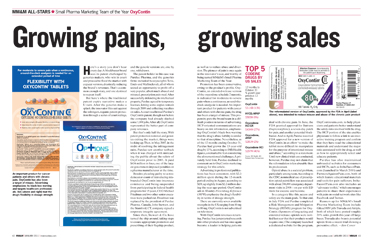AllStarsSmallPharma.pdfHere’s a story you don’t hear every day: A blockbuster brand sees its patent challenged by generics makers, who win in court and proceed to flood the market with copycat versions, drastically reducing the brand’s revenues. That’s a common enough story, and one destined to repeat itself.
But here’s where the traditional patent expiry narrative makes a U-turn. After the generics make a splash, the innovator files suit against the infringers, regains patent protection through a series of court rulings, and the generic versions are, one by one, withdrawn.
The patent holder in this case was Purdue Pharma, and the generics firms included heavyweights Teva, Endo and Mallinckrodt, all of whom seized an opportunity to profit off a very popular, albeit much abused and misused, prescription pain med. After successfully defending its intellectual property, Purdue agreed to temporary licenses, letting some copies remain through 2009 and collecting royalties on sales. A court reaffirmed Purdue’s OxyContin patent, though not before the company had already slashed some 1,800 jobs. After all, OxyContin represented the better part of company revenues.
But that’s only half the story. With patent protection restored, and generics exiting the market, things were looking up. Then, in May 2007, in the midst of resolving the infringement suits, Purdue saw another setback when it was charged with misleading the public about the safety of OxyContin prior to 2001. It paid $634 million in fines, one of the largest government-imposed penalties on a pharma manufacturer at the time.
Besides pleading guilty to a misdemeanor count of introducing misbranded OxyContin into interstate commerce and being suspended from participating in federal health programs for 15 years, CEO Michael Friedman and two other senior executives were pushed out. Friedman was replaced by the president of Purdue Pharma, Canada, John Stewart, and the Stamford, CT, company signed a corporate integrity agreement.
Since then, Stewart & Co. have turned the ship around, taking steps to ensure appropriate promotion and prescribing of their flagship product, as well as to reduce abuse and diversion. The pioneer of pain is once again in the innovator’s seat, and worthy of being named MM&M’s Small Pharma Marketing Team of the Year.
Promotion has been conservative, owing to the product’s profile. OxyContin, an extended-release version of the oxycodone schedule 2 narcotic, is indicated for moderate-to-severe pain when a continuous, around-the-clock analgesic is needed. An important product for patients with cancer and others with chronic pain, the drug has been a target of misuse. This propensity puts the brand team in a difficult position in terms of advertising. HCP-oriented communications are heavy on risk information, emphasizing OxyContin’s black-box warning that the drug’s abuse liability is similar to that of morphine. Nevertheless, as of the 12 months ending October 31, Purdue had grown the 13-year-old drug by 13%, according to IMS Health figures, a remarkable feat considering the aforementioned challenges. A privately held firm, Purdue declined to comment on its OxyContin marketing strategy for this article.
Advertising in professional publications has been consistent, with $2.3 million spent during the 12-month period ending in August, according to SDI, up slightly from $2.2 million during the year-ago period. OxyContin ads in Monthly Prescribing Reference (MPR) emphasize the drug’s flexibility in terms of dosage strength.
There are currently seven available strengths in the US, ranging from 10 mg to 80 mg. OxyContin is not advertised on television.
With OxyContin revenues returning, Purdue has jumpstarted research into other products and has once again become a leader in helping patients deal with chronic pain. In June, the FDA granted approval for Butrans (buprenorphine), a seven-day patch for pain, and another potential blockbuster. And in April, Purdue received FDA approval for a new version of OxyContin, in an effort “to make the tablet more difficult to manipulate for the purpose of intentional misuse and abuse,” according to a statement. Until new clinical trials are conducted, however, Purdue may not claim that the reformulation is less abusable than its predecessor.
Opioid abuse is a societal problem, particularly among teens. According to the CDC, nonmedical use of prescription opioid painkillers was associated with about 306,000 emergency department visits in 2008—on par with ED visits for cocaine and heroine.
In a category like this, access and safety are the main goals. To that end, in July FDA and Purdue completed a Risk Management and Mitigation Strategy (REMS) program for OxyContin. (Sponsors of long-acting and extended-release opioids were notified last year that their products would require one.) The company launched a dedicated website for the program, OxyContinrems.com, to help physicians and patients better understand the safety risks involved with the drug. The HCP portion of the site enables physicians to follow a link to an interactive training program and confirm that they have read the educational materials and understand the major risks associated with the drug, as well as how to appropriately select and educate patients.
Purdue has also maintained unbranded websites for consumers and HCPs, such as IntheFaceofPain.com (launched in March 2010) and PartnersAgainstPain.com, both of which feature educational materials and tools for pain sufferers. IntheFaceofPain.com also includes an “advocacy toolkit,” which encourages patients to share their experiences with pain on social network sites like Facebook and Twitter.
Runners up for MM&M’s Small Pharma Marketing Team include Gilead HIV pills Truvada and Atripla, both of which have posted roughly 20% sales growth this year off large bases. Truvada also boasts potential upside from a recent trial showing a preventive effect.
From the January 01, 2011 Issue of MM+M - Medical Marketing and Media








